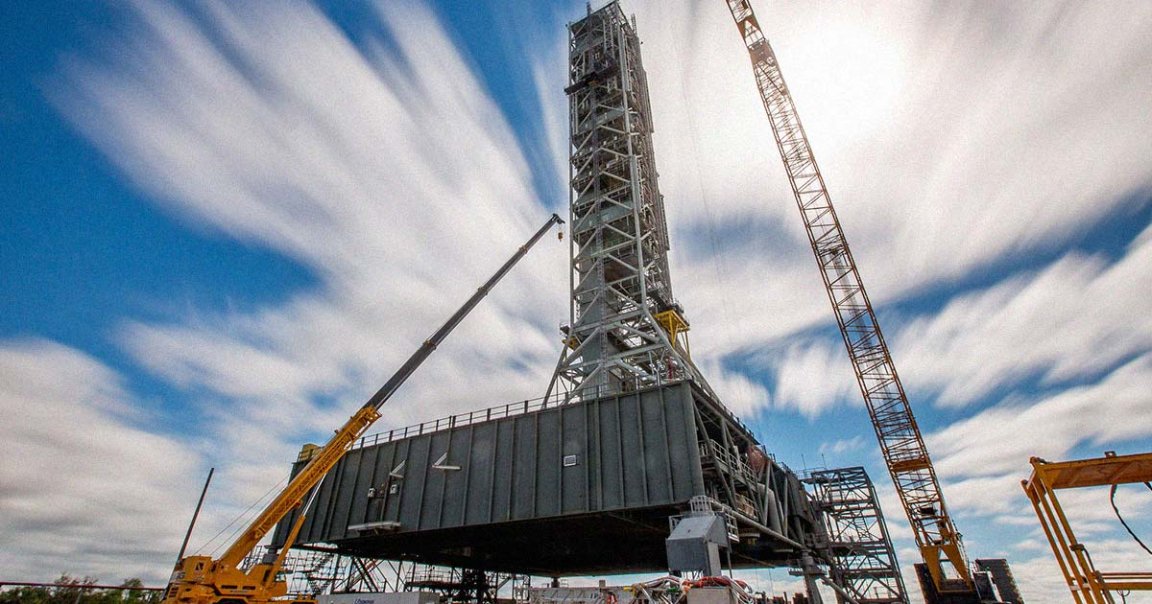
NASA’s efforts to return astronauts to the lunar surface and build an entire space station circling the Moon just got even more expensive.
The space agency’s gigantic Space Launch System (SLS), a rocket designed to launch its Orion capsule to the Moon, will need an entirely separate launch tower, dubbed Mobile Launcher 2, starting with Artemis IV.
That’s because that mission is designed to kickstart the construction of NASA’s Lunar Gateway space station, an outpost in the Moon’s orbit, no earlier than September 2028. The additional launch mass means that NASA will require an even more powerful variant of its already towering SLS — and a beefier launcher to boot.
Building the tower won’t come cheap, with NASA estimating that it’ll cost a whopping $1.8 billion and be delivered by September 2027.
Now, according to a scathing new report by NASA’s Office of Inspector General (OIG), the tower may end up being even more expensive than initially thought. The office projects that the “total cost could reach $2.7 billion” — a bewildering price tag that could greatly undermine NASA’s continued efforts to build out a more permanent presence on and around the Moon.
“Lord help us, the new cost estimate of NASA’s Mobile Launcher-2 project is now a mind-boggling $2.7 billion,” Ars Technica senior space editor Eric Berger tweeted.
The SLS has already cost NASA dearly, literally and figuratively. The project, a keystone of the agency’s Artemis program, has suffered years of delays and many billions of dollars of budget overruns. Costs have spiraled so far out of control that it’s caught the attention of lawmakers, who have argued that the program is unsustainable.
Worse yet, the NASA auditor found in its latest report that “the ML-2 will not be ready to support a launch until spring 2029, surpassing the planned September 2028 Artemis IV launch date.”
The OIG admitted that “NASA officials disagree with our analysis and expect cost growth to lessen over time,” given that the agency’s contractor Bechtel, which is building the tower, has already broken ground at NASA’s Kennedy Space Center.
However, the auditor argued that Bechtel was continuing to underestimate the project’s scope, resulting in “cost increases in several categories, including labor, equipment, and administrative expenses.”
The report may serve as a wake-up call to NASA. In 2022, amid reports that each of NASA’s Artemis launches could cost as much as $4.1 billion, the OIG already rang the alarm bells over the ballooning costs of ML-2.
At the time, the auditor found that NASA was estimated to spend “at least 2.5 times more than initially planned” for the contractor, in addition to a 2.5-year delay.
“Costs going up faster than the tower,” self-described internet rocket scientist Scott Manley joked at the time.
NASA used its Mobile Launcher 1 for its inaugural — albeit uncrewed — Artemis mission in late 2022. According to a 2020 audit, the tower, which was originally built for NASA’s canceled Constellation program, cost $234 million to develop.
That tower will be used for Artemis missions I through III, which includes NASA’s first attempt to land astronauts on the Moon’s surface. But for Artemis IV and beyond, NASA needs to build an entirely separate tower to accommodate the even taller Block 1B configuration of the SLS.
Once fully constructed, NASA’s second mobile launch tower will be roughly seven feet taller than its first, despite Block 1B being 40 feet taller than its predecessor.
Even the rocket is already way behind schedule. In a similarly scathing report earlier this month, the OIG found an “array of issues” plaguing Boeing’s development of the Block 1B rocket.
The timing couldn’t be worse, with Boeing still reeling from NASA’s decision to return its plagued Starliner spacecraft without a crew on board.
With costs spiraling out of control, NASA will have some hard questions to answer. Its Moon rocket has already proven extremely unpopular, with Congress demanding NASA to “reaffirm” its development given the eye-watering price tag last month.
Meanwhile, SpaceX’s equally massive Starship spacecraft is waiting in the wings. In fact, NASA is hoping to use a “Human Landing System” variant of the rocket for its Artemis IV mission to ferry astronauts from the Moon’s orbit down to the surface.
Which leaves the uncomfortable question: couldn’t NASA just rely on Starship instead?
More on SLS: NASA Inspector Slams Boeing for Shoddy Work on Moon Rocket